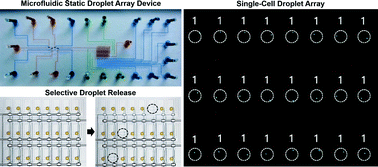A highly addressable static droplet array enabling digital control of a single droplet at pico-volume resolution†
Abstract
Droplet-based microfluidics enabling exquisite liquid-handling has been developed for diagnosis, drug discovery and quantitative biology. Compartmentalization of samples into a large number of tiny droplets is a great approach to perform multiplex assays and to improve reliability and accuracy using a limited volume of samples. Despite significant advances in microfluidic technology, individual droplet handling in pico-volume resolution is still a challenge in obtaining more efficient and varying multiplex assays. We present a highly addressable static droplet array (SDA) enabling individual digital manipulation of a single droplet using a microvalve system. In a conventional single-layer microvalve system, the number of microvalves required is dictated by the number of operation objects; thus, individual trap-and-release on a large-scale 2D array format is highly challenging. By integrating double-layer microvalves, we achieve a “balloon” valve that preserves the pressure-on state under released pressure; this valve can allow the selective releasing and trapping of 7200 multiplexed pico-droplets using only 1 μL of sample without volume loss. This selectivity and addressability completely arranged only single-cell encapsulated droplets from a mixture of droplet compositions via repetitive selective trapping and releasing. Thus, it will be useful for efficient handling of miniscule volumes of rare or clinical samples in multiplex or combinatory assays, and the selective collection of samples.


 Please wait while we load your content...
Please wait while we load your content...